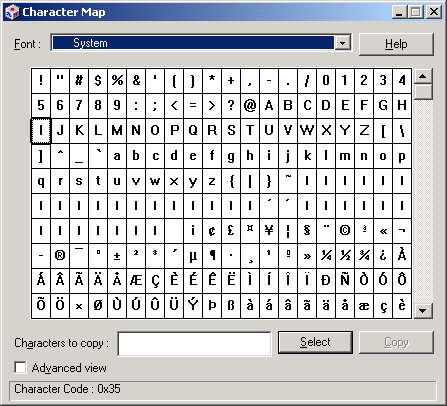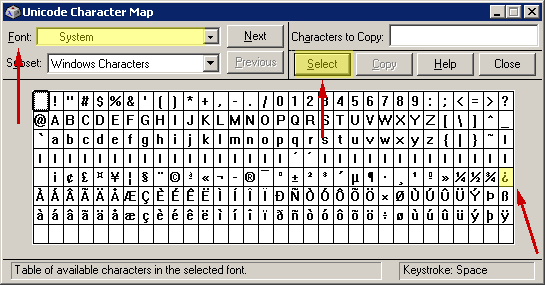Character Map Utility
Windows 2000 & NT
The Character Map utility is free on all Windows machines and can be used to copy and paste accented letters and other foreign language characters characters into any Windows application. The Character Map is similar to the Insert Symbol tool found in some Windows applications such as Microsoft Word.
This Page
Windows 2000 Instructions
These instructions are written for Windows 2000. If your P C has an older version of Windows please refer to the older Windows instructions.
To open the Character Map utility:
- Click on the Windows Start menu on the lower left of your screen.
- Select Programs » Accessories » System Tools » Character Map.
NOTE: On other P C's, the Character Map may be in another location under Accessories or the Start menu. - A window should open which displays a series of characters in a grid as in the image below

In the Character Map
- Make sure that the Font from the dropdown list matches that of the document you are creating. If you doing some other function, such as filling out a Web form, select System as the Font.
- If the character you want to insert is listed, proceed to Step #4, you may need to scroll down a little to check.
- If the character you want is not in the grid, change the Font to Arial Unicode MS, Lucida Sans Unicode, Tahoma, Times New Roman, Arial or some other appropriate font.
- Double-click on any character you wish to insert then click the Select button to make it appear in the Characters to Copy field. You can Select more than one character at this time.

- Highlight one or more of the characters in the Characters to Copy you wish to insert then click the Copy button.

- Minimize from the Character Map window, and open or switch to the application window in which you wish to insert a the character.
- Position your cursor in the location you wish to insert the character.
- Under the Edit Menu, choose Paste (or use the keyboard shortcut Control+V). The character should appear.
- If necessary, change the font of the inserted character to the one selected in the Character Map.
Windows NT
These instructions are based on Windows NT , but should be similar to other versions of Windows. If your P C has Windows 2000, please read the Windows 2000 instructions.
To open the Character Map utility:
- Click on the Windows Start menu on the lower left of your screen.
- Select Programs » Accessories » System Tools » Character Map.
NOTE: On other PCs, the Character Map may be in another location under Accessories or the Start menu.
- A window should open which displays a series of characters in a grid.
In the Character Map:
- Make sure that System is selected in the Font dropdown list and that Windows Characters is selected in the Subset dropdown list.
- If the character you want to insert is listed, proceed to the next step. Otherwise, change the Font to Lucida Sans Unicode, Arial Unicode MS, Tahoma or some other appropriate font. and change the Subset to one which contains the character you need to insert.
- Double-click on any character you wish to insert then click the Select button to make it appear in the Characters to Copy field. You can Select more than one character at this time.

- Highlight one or more of the characters in the Characters to Copy you wish to insert then click the Copy button.

- Minimize from the Character Map window, and open or switch to the application window in which you wish to insert a the character.
- Position your cursor in the location you wish to insert the character.
- Under the Edit Menu, choose Paste (or use the keyboard shortcut Control+V). The character should appear.
- If necessary, change the font of the character to the one selected in the Character Map.